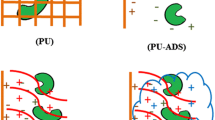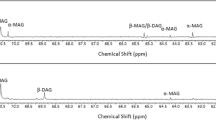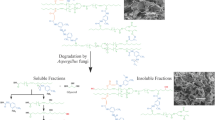Abstract
The aim of this study was to investigate eventual relationships between some physico-chemical properties (e.g. porosity, aquaphilicity, partition coefficient for oleic acid and drying curves) of relatively hydrophilic polyurethane foams and the activity and batch operational stabiliy of Candida rugosa lipase immobilized within these foams. Two biocompatible polyurethane pre-polymers (“HYPOL FHP 2002TM” and “Hypol FHP X4300TM” from Hampshire Chemical GmbH, Germany) were tested as immobilization supports. The model reaction was the hydrolysis of crude olive residue oil in a biphasic aqueous/n-hexane medium.
Drying curves under normal and reduced pressures suggested that water molecules are more strongly bound to the “FHP 2002” than to “FHP X4300” foams. This is in agreement with the higher aquaphilicity value estimated for the “FHP 2002” foam (3.7 vs 2.8).
For every enzyme loading tested, hydrolysis efficiency was considerably higher for the lipase in “FHP X4300” foam when compared to the other counterpart. However, internal mass transfer limitations seem to be more severe with “FHP X4300” foams.
Operational stability was evaluated in 10 consecutive batches (1 batch = 23 hours) for both immobilized preparations. A fast deactivation was observed for both biocatalysts. However, a slightly higher operational stability was observed for the lipase in “FHP 2002” foam. For the lipase in “FHP X4300” foam, the activity decay can be explained by a dramatic lipase leakage from the foam observed along successive batches. For the lipase in “FHP 2002” foam, no significant enzyme loss was observed along the reutilizations probably due to a higher number of multi-point attachment between the lipase and its support.
In fact, activity and operational stability of Candida rugosa lipase in “FHP 2002” and “FHP X4300” foams appear to be related with the strength and/or the number of covalent binding between the enzyme and the support rather than to the physico-chemical properties evaluated in this work.
Similar content being viewed by others
Author information
Authors and Affiliations
Additional information
Received: 7 January 1999
Rights and permissions
About this article
Cite this article
Ferreira-Dias, S., Correia, A. & Baptista, F. Activity and batch operational stability of Candida rugosa lipase immobilized in different hydrophilic polyurethane foams during hydrolysis in a biphasic medium. Bioprocess Engineering 21, 517–524 (1999). https://doi.org/10.1007/PL00009090
Issue Date:
DOI: https://doi.org/10.1007/PL00009090




